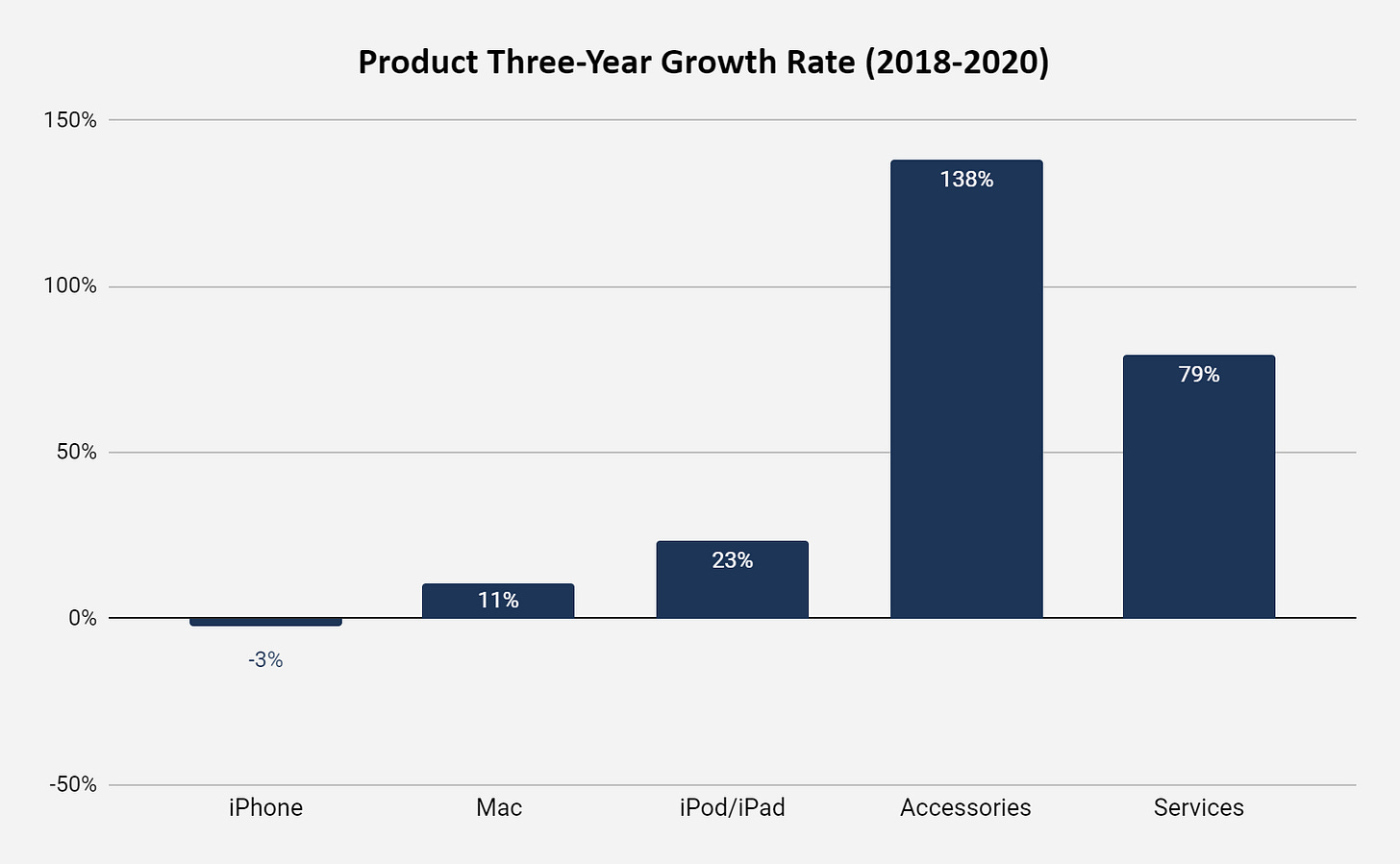Apple's Five Phases
Analyzing how Apple's product mix has changed over the last twenty years.
Summary
Over the past twenty years, Apple has gone through five different “phases”, which are identified by looking at the product mix in the company’s business model.
We will look at each phase individually and then attempt to predict what this means for Apple’s future with no major new products currently on the horizon.
The Mac Phase
For the company’s first 25 years, Apple was a computer manufacturing company. Remember that Apple’s official business name was “Apple Computer, Inc.” all the way up until 2007!
This is why we start the “phases” in 2000, one of the last years in which Apple did not have another device that made up significant revenue. In 2000, the company’s “services” business was primarily related to computer software, computer displays, and wireless networking technology. The total services business made up only about $1 billion, so pennies compared to Apple’s business today.
The Breakthrough Phase
Steve Jobs made his famous return to Apple in 1997. Four years later, he launched the iPod - a device that could hold 1,000 songs in a 6.5 ounce device that can slide into your pocket.
This was Apple’s first non-computer product breakthrough in its then 25-year history. By 2005, the iPod made up 32.6% of Apple’s total revenue and passed the Mac in revenue a year later.
In the first six years of the iPod, Apple’s stock increased 600%, a sign that Apple investors hoped for a future instead of just making computers. A true breakthrough.
The Rocket Ship Phase
In the five years after 2005, Apple launched the iPhone, MacBook, iPad, and the iPod Touch. This will be remembered in business history for the incredible amount of innovation and scale that one company reached in such a short time period.
The result of this innovation?
Revenue increases 4x from 2005 to 2010.
Apple’s stock increase 800% from the start of 2005 to the end of 2010.
Apple becomes the most valuable company in the world in 2011.
We could write 100,000 words on this era in Apple’s history and no name for this phase could do justice to the incredible technological advancements Apple made.
The Execution Phase
When Steve Jobs passed away in October 2011, many believed Apple would never be the same. While that is true in some ways, the show had to continue.
Tim Cook, then the company’s chief operating officer, took over as CEO and has since led Apple through a phase of strong growth during a time in which many thought Apple would falter.
This phase is called the execution phase as the company grew revenue in all five categories but grew free cash flow even faster. In the first quarter of 2015, Apple was worth $725 billion, more than double the second largest company in the world, which was Exxon Mobil at $356 billion.
The Ecosystem Phase
If you asked any Apple executive seven years ago what the perfect product mix would be in 2020, the chart above is likely exactly what they would have dreamed of.
Let’s put this 2020 chart into the perspective of Apple executives in 2015:
The iPhone makes up 50.2% of the company’s revenue, down from 66.3% in 2015, which is encouraging because that means the iPhone has maintained strong market share across the world, is the main driver for the company’s accessories and services businesses, but the company isn’t solely dependent on it for revenue.
The iPad and Mac make up a healthy 20% of the company’s total revenue, which serves as a way to diversify away from the smartphone market, and also keep users in the Apple device ecosystem.
Non-device sales, which are the accessories and services businesses, make up a very strong 30% of revenue. In addition to being strong revenue drivers, these products have significantly higher margins than the company’s devices. Apple reported in Q4 2022 that they have a 70.5% profit margin on their services business compared to 34.6% profit margin on products.
So what is the ecosystem? Apple’s ecosystem strategy is to get consumers so hooked onto Apple products that they are almost forced to continue to purchase Apple them.
If you have an iPad, MacBook, and Apple Watch, how likely is that you are going to switch from an iPhone to an Android smartphone? We don’t have the data, but we know Apple does, and we bet the answer is in the low single digits.
The ecosystem strategy has allowed Apple to sell new products and services like AirPods, Apple Watch, and Apple Pay to their increasingly growing customer base around the world.
The Next Phase
The chart above shows the cumulative growth rate for each of Apple’s five products from 2018 to 2020. The takeaway is that revenue from Apple’s non-device products are growing significantly faster than revenue from devices.
Using these growth rates, we can forecast revenue for the next three years to get us to a product mix for 2025.
Here is how the share of each product changes from 2020 to our 2025 forecast:
iPhone share drops from 50.2% to 43.1%
Mac share drops from 10.4% to 8.8%
iPod/iPad share drops from 8.6% to 6.4%
Accessories share increases from 11.2% to 13.3%
Services shares increases from to 19.6 to 28.3%
Let’s add these projections to our original timeline chart:
What would this 2025 projected phase be called? The “services” phase? The “super-balanced” phase? Only time will tell.
If history has told us anything, we have not been very good at predicting future Apple product launches and their revenue trajectories. Part of this is that Apple is notoriously quiet about their future products and the other part is its hard to grasp how strong Apple’s ecosystem is.
Can you envision a future in which a new product other than the iPhone makes up over 50% of Apple’s revenue?












